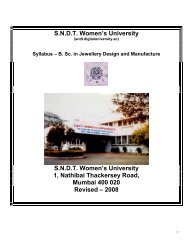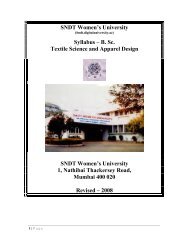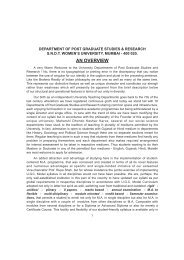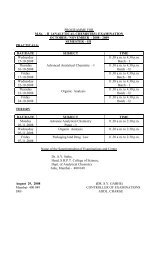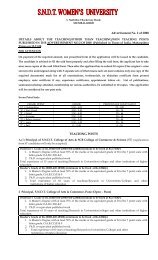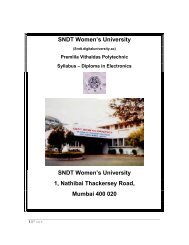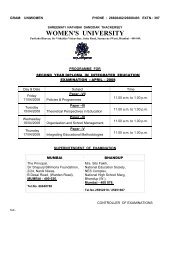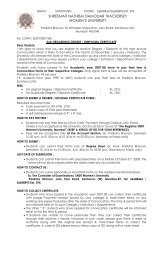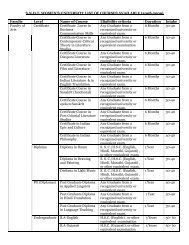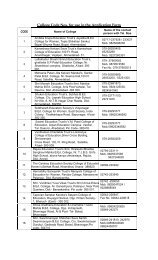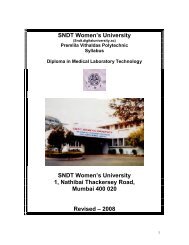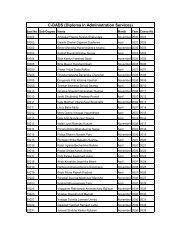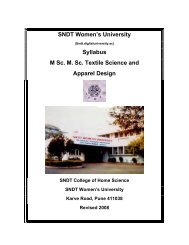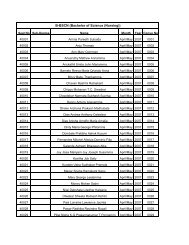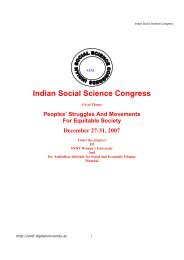SNDT Women's University Syllabus â M. Sc. Analytical Chemistry ...
SNDT Women's University Syllabus â M. Sc. Analytical Chemistry ...
SNDT Women's University Syllabus â M. Sc. Analytical Chemistry ...
You also want an ePaper? Increase the reach of your titles
YUMPU automatically turns print PDFs into web optimized ePapers that Google loves.
<strong>SNDT</strong> Women’s <strong>University</strong><br />
(Sndt.digitaluniversity.ac)<br />
<strong>Syllabus</strong> – M. <strong>Sc</strong>. <strong>Analytical</strong> <strong>Chemistry</strong><br />
<strong>SNDT</strong> Women’s <strong>University</strong><br />
1, Nathibai Thackersey Road,<br />
Mumbai 400 020<br />
Revised – 2008<br />
1 | P a g e
Eligibility:<br />
B.<strong>Sc</strong>. <strong>Chemistry</strong><br />
B.<strong>Sc</strong>. Microbiology with 5 Units in the subject of <strong>Chemistry</strong><br />
Objective:<br />
a) To provide access to the field of higher education for women.<br />
b) To provide a job-Oriented course to meet the socio-economic demands.<br />
c) To arrange in-plant training programme to provide opportunities for experiential<br />
learning.<br />
d) To Develop scholarship and research in emerging areas of study.<br />
e) To achieve excellence in the academic disciplines, research and extension activities<br />
through emphasis on ‘Quality in every activity’<br />
SYLLABUS FORMAT<br />
Faculty ame: <strong>Sc</strong>ience<br />
Course ame : M <strong>Sc</strong>. – <strong>Analytical</strong> <strong>Chemistry</strong><br />
SCHEME:<br />
Semester I<br />
Subjects L Cr P D TP TW P/V T<br />
1 <strong>Analytical</strong> chemistry Paper I 4 10 12 3 100 50 50 200<br />
2 Food Analysis 4 10 12 3 100 50 50 200<br />
Total 08 20 24 6 200 100 100 400<br />
Semester II<br />
Subjects L Cr P D TP TW P/V T<br />
1 <strong>Analytical</strong> <strong>Chemistry</strong> II 4 10 12 3 100 50 50 200<br />
2 Pharmaceutical Analysis 4 10 12 3 100 50 50 200<br />
Total 8 20 24 6 200 100 100 400<br />
2 | P a g e
Semester III<br />
Subjects L Cr P D TP TW P/V T<br />
1 Advance <strong>Analytical</strong> <strong>Chemistry</strong> I 4 10 12 3 100 50 50 200<br />
2 Organic Analysis 4 10 12 3 100 50 50 200<br />
3 Packaging & Drug Laws 4 10 -- 3 100 -- -- 100<br />
Total 12 30 24 9 300 100 100 500<br />
Semester IV<br />
Subjects L Cr P D TP TW P/V T<br />
1 Advance <strong>Analytical</strong> <strong>Chemistry</strong> II 4 10 12 3 100 50 50 200<br />
2 Microbiological Method of Analysis 4 10 12 3 100 50 50 200<br />
Cosmetic & Water Analysis 4 10 12 3 100 50 50 200<br />
-<br />
3<br />
Total 12 30 36 9 300 150 150 600<br />
Industrial Training: At the end of the IV Semester, the Students go for 2 Months<br />
Industrial Training.<br />
L = o. of Lectures / week, P / T = Practical / Tutorial in hrs, D = Duration of Theory<br />
paper for Examination in hrs, TP = Theory Paper-marks, Internal = Internal<br />
Assessment in marks, P/V = Practical / Viva Voce - marks, T = Total<br />
Semester I<br />
Subjects L Cr P D TP TW P/V T<br />
1 <strong>Analytical</strong> chemistry Paper I 4 10 12 3 100 50 50 200<br />
Sr. Topic and Details<br />
Marks Weight<br />
No.<br />
assigned age in %<br />
1 <strong>Analytical</strong> <strong>Chemistry</strong> – scope, functions, analytical process. 2 5<br />
2 Sampling – Collection, Preservation and preparation of sample,<br />
Techniques of sampling solids, liquids and gases, Operation of drying<br />
and preparing a solution of the analyte.<br />
5 5<br />
3 Introduction to Volumetric Method of Analysis:- 10 10<br />
Calibration of volumetric apparatus, Primary and Secondary<br />
standards, Principals of volumetric analysis, Acid – base titration.<br />
Titration in non-aqueous solvents, Complexometric titrations,<br />
Precipitation titrations, Redox titrations, Theoretical aspects of<br />
titration curves and end point evaluation, Choice and suitability of<br />
indicators in each case.<br />
4 Introduction to Gravimetric Analysis:- 3 2<br />
3 | P a g e
Precipitation reactions, conditions of precipitation, nucleation,<br />
particle size, crystal growth, colloidal state, aging, impurities in the<br />
analytical precipitate, co-precipitation, precipitation from<br />
homogenous solution, drying and ignition of precipitation,<br />
Applications.<br />
5 Solvent extraction- 5 5<br />
Efficiency of extraction, Selectivity of extraction, Extraction system,<br />
Method of Extraction, applications.<br />
6 Chromatographic methods:- 5 15<br />
Principals, classification of chromatographic techniques, Technique<br />
and applications of paper chromatographic, Thin – layer<br />
chromatographic, HPTLC, Column chromatography.<br />
7 SECTION II (30 Credits) Statistics. 30 30<br />
Evalution and Procession of <strong>Analytical</strong> Data, Precision and Accuracy,<br />
Types of Errors, Normal Distribution Curve, Standard deviation,<br />
Confidence limit, Graphical presentation of result- Method of<br />
average, Method of Linear list square, Significant figures, Statistical<br />
aid to hypothesis testing-t –test, F-test, ci 2 test, Correlation<br />
coefficient, Rejection of data.<br />
REFERENCES:-<br />
Fundamental of <strong>Analytical</strong> <strong>Chemistry</strong>-Skoog D.A. and West D.M.<br />
Saunders, College Publication<br />
Textbook of Quantitative Inorganic Analysis-Vogel A.I.<br />
Principles and Practice of <strong>Analytical</strong> <strong>Chemistry</strong>-Fifield F.W. and Kealey<br />
D, Black well <strong>Sc</strong>ience<br />
Instrumental Analysis R. Braun, Mcgraw Hill, International Edition<br />
<strong>Analytical</strong> <strong>Chemistry</strong>, Christain, WSE / Wiley<br />
Instrumental Analysis, Willard Merilt, CBS.<br />
Chemical Analysis, Brawn, Mcgraw Hill.<br />
Chemical Analysis, Underwood PH Publication Co.<br />
4 | P a g e
Subjects L Cr P D TP TW P/V T<br />
2 Food Analysis 4 10 12 3 100 50 50 200<br />
Sr.<br />
No.<br />
Topic and Details<br />
Objective :- To familarise students with theoretical aspects and<br />
application to analysis of food.<br />
Marks<br />
assigned<br />
1 Introduction to foods 5 5<br />
2 Introduction to general Constituents of foods 10 10<br />
3 Proximate Constituents and their analysis 5 10<br />
4 Additives – Introduction – Types – Study of preservatives colours and<br />
Antioxidants and method of estimation<br />
5 10<br />
5 Adulteration- Introduction, Types, Tests for adulterants, Control 10 10<br />
6 Introduction, standards composition and analysis of following foods :- 20 50<br />
Wheat, Bread, Biscuits, Jam, Jelly, Honey, Milk, Ice Cream, Butter,<br />
Cheese, Milk Powder, Oils and Fats, Tea, coffee, Soft drinks, Alcoholic<br />
beverages, Cercals and pulses, Confectionery, Fruits, Vegetable, Egg,<br />
Fish, Meat.<br />
7 Techniques of Analysis:- 5 5<br />
Introduction to Instrumental and Non-instrumental method and<br />
applications.<br />
REFERENCES:-<br />
Pearson’s Chemical /analysis of food – Persons Orient Longman 1998<br />
Food Analysis –Nielsen 2000<br />
AOAC – Recent edition.<br />
Food Analysis, Pomeranz, Meloan, Chapman Hall<br />
Module # 3 PRACTICALS - Volumetric Analysis – Preparation and<br />
Standardization of commonly used titrants, Acid-base titration, Redox<br />
titration, Complexometric titration, Precipitation titration, Nonaqueous<br />
titration.<br />
Module # 4 PRACTICALS – Gravimetric Analysis-Gravimetric<br />
estimations of metals.<br />
25 25<br />
25 25<br />
Module # 5 PRACTICALS – Food Analysis – Milk and Milk Products 25 25<br />
Module # 6 PRACTICALS – Food Analysis – Jam, Tea, Squash, Edible<br />
Oil<br />
25 25<br />
Weight<br />
age in %<br />
5 | P a g e
Semester II<br />
Subjects L Cr P D TP TW P/V T<br />
1 <strong>Analytical</strong> <strong>Chemistry</strong> II 4 10 12 3 100 50 50 200<br />
Sr.<br />
o.<br />
Topic and Details<br />
Module # 7 ANALYTICAL CHEMISTRY – II (Modern method of<br />
Analysis)<br />
Marks<br />
assigned<br />
Weight<br />
age in %<br />
Objective :- To familiarize students with concepts of spectroscopy<br />
and electrochemistry<br />
1 <strong>Analytical</strong> Spectrometry:- 5 10<br />
Interaction of radiation with concepts matter, Beer’s law. Deviation<br />
from Beer’s law.<br />
2 Ultraviolet and visible spectrometry:- 10 10<br />
Instrumentation. Absorbing species. Qualitative and Quantitative<br />
analysis<br />
3 Infrared Spectrometry:- 10 10<br />
Theory of Infrared Absorption. Spectometry. Instumentation. Sasmple<br />
handling. Qualitative and Quantitative analysis.<br />
4 Flame emission Spectrometry:- 5 10<br />
Instrumentation. Flame characteristics. Flame processes, Emission<br />
Spectra, Quantitative measurements, Interferences, Application.<br />
5 Atomic absorption Spectrometry:- 8 10<br />
Theory of atomic absorption spectrometry, Instrumentation,<br />
interferences,<br />
6 Turbidimetry and Nephelometry:- 3 10<br />
Theory, Instrumentation, Applications.<br />
7 Potentiometry:- 5 10<br />
Electrodes, electrode systems, Determination of cell EMF,<br />
Potentiometric titrations,<br />
8 Conductometry:- 3 10<br />
Principles, Instrumentation, <strong>Analytical</strong> applications.<br />
6 | P a g e
9 Coulometry:- 3 10<br />
Basic Principles, Potentiostatic coulometry titrations, Stripping<br />
analysis<br />
10 Polarography:- 8 10<br />
Basic principles, Diffusion current, polarized electrode, Micro<br />
electrode, Dropping Mercury Electrode IIkovic equation,<br />
Polarographic wave, Qualitative, and Quantitative analysis, Stripping<br />
methods.<br />
REFERENCES:-<br />
Fundamentals of <strong>Analytical</strong> <strong>Chemistry</strong>-Skoog D.A and West D.M,<br />
Saunders.<br />
<strong>Analytical</strong> <strong>Chemistry</strong>-Christain G.D, Wiley WSE.<br />
Textbook of Quantitative Inorganic Analysis, Menohemetal, Pearson<br />
Educatoin<br />
Principles and Practice of <strong>Analytical</strong> <strong>Chemistry</strong>-Fifield F.W. and Kealey<br />
D, Blackey Academic<br />
7 | P a g e
Subjects L Cr P D TP TW P/V T<br />
2 Pharmaceutical Analysis 4 10 12 3 100 50 50 200<br />
Sr.<br />
o.<br />
Topic and Details<br />
Marks<br />
assigned<br />
Weight<br />
age in %<br />
Module # 8 PHARMACEUTICAL ANALYSIS<br />
Objective:-<br />
To Familiarize students with theoretical aspects<br />
pharmaceutical analysis<br />
1 Introduction to drugs 5 10<br />
2 - Introduction, Tablets, Capsules, Injections, Ointments,<br />
Creams, Oral solution, Aerosol.<br />
10 20<br />
3 Pharmacopoeia:- 10 10<br />
4 Impurities and Limit test 5 10<br />
5 Techniques of Analysis-Introduction-PRACTICALS considerations and<br />
application.<br />
Gravimetric-Volumetric-Physical-Chemical,<br />
Chromatographic-UV-Visible-IR fluorimetry-Flame Photometry.<br />
6 Assay of main classes of drugs Chemotherapeutic agents-with<br />
reference to Introduction-Type-Properties-Method of Analysis.<br />
10 10<br />
20 40<br />
REFERENCES:-<br />
Beckett & Stenlake-Vol. (I) (II) PRACTICALS Pharmaceutical chemistry,<br />
Athlone Press London<br />
Connors-Text Books of pharmaceutical Analysis-J. Wiley 2001<br />
Chemical Analysis of Drug Higuchi, Interscience 1995<br />
Remingtons Pharmaceutical <strong>Sc</strong>ience 2000<br />
Dosage form-Aulton 1996<br />
Module # 9 PRACTICALS-Colorimetric-Colorimetric analysis of<br />
mixture, Simultaneous estimation of metals spectrophotometrically,<br />
pk value of indicator by Specrophotometry<br />
Module # 10 PRACTICALS-Chromatography- lon- exchange<br />
chromatography, Thin layer chromatography.<br />
Module # 11 PRACTICALS – Pharmaceutical Analysis-Assay of<br />
alkahoids, Vitamins, Antibiotic, Sulphadrugs.<br />
Module # 12 PRACTICALS – Pharmaceutical Analysis-Dissolution<br />
test, Disintegration test, Weight Variation test, Test for uniformity of<br />
content.<br />
10 20<br />
10 20<br />
10 20<br />
20 40<br />
8 | P a g e
Semester III<br />
Subjects L Cr P D TP TW P/V T<br />
1 Advance <strong>Analytical</strong> <strong>Chemistry</strong> I 4 10 12 3 100 50 50 200<br />
Sr.<br />
o.<br />
Topic and Details<br />
Module # 13 Advanced <strong>Analytical</strong> <strong>Chemistry</strong> –I (Chromatographic and<br />
Spectral Methods)<br />
Marks<br />
assigned<br />
Weight<br />
age in %<br />
Objective :- To familiarize students with theoretical aspects of column<br />
chromatographic methods and spectral methods<br />
(A) Chromatography:-<br />
1 GLC :- Principal of GL.C. Instruments for GLC –Gas Chromatographic<br />
Columns and Stationary phases. Applications.<br />
5 10<br />
2 HPLC :- Principals of HPLC. Instrumentation. 5 10<br />
3 Ion Chromatography:- 5 5<br />
Ion exchange Equilibria. Ion-exchange packings. Inorganic Applications<br />
of Ion Chromatography<br />
4 Exclusion (Size) Chromatography:- 5 5<br />
Column packing, Theory of size of exclusion chromatography.<br />
Application of size exclusion chromatography.<br />
5 Supercritical Fluid Chromatography:- 5 10<br />
Properties of supercritical Fluid SFC-Instrumentation and operating<br />
variables, comparison with other types of chromatography.<br />
Applications.<br />
6 Capillary Electrophoresis and Capillary Electro<br />
chromatography:-<br />
Over view of Electrophoresis, capillary electrophoresis, Applications of<br />
capillary Electrophoresis capillary electro chromatography.<br />
5 10<br />
(B) Spectroscopy:-<br />
1 Molecular Luminescence spectroscopy:- 5 5<br />
Theory of fluorescence and phosphorescence, variable that affects<br />
fluorescence and phosphorescence. Instruments for measuring<br />
fluorescence, phosphorescence, application of fluorescence and<br />
phosphorescence.<br />
2 NMR:- Theory of NMR-Quantum description, classical description of<br />
NMR, Relaxation Processes in NMR. Environmental effects on NMR<br />
5 10<br />
9 | P a g e
Spectra-Chemical shift, spin splitting. Rules governing the<br />
interpretation of first order spectra. Effect of chemical exchange. NMR<br />
Spectrometers Applications of proton NMR, c-13 NMR.<br />
3 ESR:- Principals, Instrumentation, ESR spectra. 5 10<br />
4 X-Ray Fluorescence method:- Principals-Characteristics x-ray emission. 5 10<br />
Instrumentation x-ray tube, Radioactive sources. Wavelength<br />
dispersive instruments. Energy dispersive instruments. <strong>Analytical</strong><br />
Applications-Qualitative Analysis-Quantitative Analysis.<br />
5 Photo acoustic spectroscopy:- 5 5<br />
6 Photo acoustic effect, spectra, Instruments, Applications. 5 10<br />
Atomic Emission Spectroscopy:- Principal, Instrumentations and<br />
Applications.<br />
Reference:<br />
1) Ewings <strong>Analytical</strong> Instrument hand book – Cazes, Marcel Dekkar<br />
2)<strong>Analytical</strong> <strong>Chemistry</strong>, Kellner etal, Wiley VCH<br />
3)Instrumental Techniques for <strong>Analytical</strong> Chemstry settle – PTR PH<br />
4)Deans <strong>Analytical</strong> <strong>Chemistry</strong> Handbook – Patnaik, Mcgraw Hill Co.<br />
Module # 14 : PRACTICALS:- Advanced spectral methods –<br />
spectroscopy determination of elements. Standard addition method<br />
and method of least squares extractive photometry, photometric<br />
titration.<br />
Module # 15 : PRACTICALS :- Fluorimetry flame photometry –<br />
fluorimetry, flame photometry<br />
REFERENCES :-<br />
1) <strong>Analytical</strong> <strong>Chemistry</strong><br />
Edited by R. Kellner, J.M. Mermet, Motto.<br />
2) Principal of instrumental analysis<br />
Skoog Holler – Niemann.<br />
3) Principal of Instrumental analysis<br />
Skoog D.A. and West D.M.<br />
4) Instrumental analysis<br />
Wi;;ard, Dean and merit<br />
5) Instrumental analysis<br />
Ewing<br />
6) Principal and PRACTICALS analytical chemistry<br />
Fifield and Kealey<br />
25 25<br />
25 25<br />
10 | P a g e
Subjects L Cr P D TP TW P/V T<br />
2 Organic Analysis 4 10 12 3 100 50 50 200<br />
Sr.<br />
o.<br />
Topic and Details<br />
Module # 16 ORGANIC ANALYSIS<br />
Marks<br />
assigned<br />
Weight<br />
age in %<br />
Objective:- To familiarize student with theoretical aspects of organic<br />
analysis.<br />
1 I Organic Micro-analysis:- 15 20<br />
11 | P a g e<br />
Detections of elements like carbon, hydrogen, nitrogen, oxygen,<br />
halogen, sulphur and some metallic elements by traditional method<br />
and modern method like modified elements analyzer, pyrolytic<br />
reduction, coulometer at control potential and Gravimetric methods.<br />
2 II Functional group analysis:- 15 20<br />
Hydroxyl group like alcohols, Glycols, Phenols by esetrification<br />
procedure with various reagents.<br />
Carbonyl group by Oxime, Bisulphite, Hydrazone, Oxidation, <strong>Sc</strong>hiff’s<br />
base methods.<br />
Carboxylic acids and its derivatives (salt, esters, amides, chlorides<br />
anhydrides) by titrimetric, Combustion, Saponification, Potentiometric,<br />
and Reduction methods.<br />
Amino group by titration, Acylation, Drazotization, Bromination<br />
methods.<br />
Unsaturation by Bromination. Iodine number, Hydrogenation.<br />
Ozonization, epoxidation methods.<br />
Alkoxyl group by acidimetric and Iodometric methods.<br />
3 III Spectrometric identification of organic compound:- 15 50<br />
Ultraviolet and visible spectroscopy:-<br />
General applications to Isolated double bond, conjugated dienes,<br />
functional groups, halogens, Aromatic system monocyclic, polycyclic<br />
heteroaromatic compound etc. Shift of bands in spectra with various<br />
solvents used. Problems based on spectra analysis.<br />
Infrared Spectroscopy:-<br />
Interpritation of IR Spectroscopy, Finger print region, characterization
of functional groups and frequency shifts associated with structural<br />
elucidation.<br />
Nuclear magnetic resonance spectroscopy:-<br />
PMR spectrum an introduction to:-<br />
Types of Protons (equivalent and non equivalent), chemical shift,<br />
signal intensities, spin-spin splitting. Application of PMR spectroscopy<br />
in structure elucidation.<br />
Carbon –13 NMR Spectroscopy:-<br />
Multiplicity – H decoupling, Noise decoupling, off resonance<br />
decoupling, chemical shifts, correction in shifts of aromatic carbon<br />
atoms of mono substituted benzenes. Spectrometric identification of<br />
organic compounds.<br />
4 IV Organic trace analysis:- 15 10<br />
General aspects, sampling, treatment of sample before analysis,<br />
separation method and concentration steps, detection of compound,<br />
applications of trace analysis.<br />
Module # 17 : PRACTICALS :- Identification of functional groups<br />
Alcoholic group, phenolic group carbonyl group, carboxylic group,<br />
ester group, nitro group, amino group, amide group hydrocarbons<br />
unsaturation<br />
Module # 18 : PRACTICALS :- Estimation of functional group like<br />
alcoholic hydroxyl, phenolic, amino, carboxylic ketones and aldehyde,<br />
Estimation of unsaturation, amide alkoxy, amino acids etc.<br />
25 25<br />
25 25<br />
12 | P a g e<br />
REFERENCES:-<br />
1) Modern Organic elemental analysis<br />
By :- T.S. Ma and R.C. Rittner<br />
2) Quantitative organic analysis via functional group<br />
By :- S. Siggia and J.C. Hanna<br />
3) Spectrometric identification of organic compounds<br />
By :- R. M. Silverstein, G.C. Bassler and T.C. Morrill, J. Wiley &<br />
Sons<br />
4) Application of absorption spectroscopy of organic compounds<br />
By :- J.R. Dyer
5) Organic trace analysis<br />
By :- K. Beyermann<br />
6) Spectroscopic method in organic chemistry<br />
By :- D.H. Williams and I Fleming<br />
7) NMR and <strong>Chemistry</strong><br />
By :- J.W. Akitt<br />
8) Modern experimental organic chemistry<br />
By :- R.M. Roberts, J.C. Gilbert, L.B. Rodewald and A.S.<br />
Wingrove<br />
13 | P a g e
Subjects L Cr P D TP TW P/V T<br />
3 Packaging & Regulating Aspects 4 10 12 3 100 50 50 200<br />
Sr.<br />
o.<br />
Topic and Details<br />
Module # 19 Packaging & Regulatory Aspects.<br />
Marks<br />
assigned<br />
Weight<br />
age in %<br />
Objective :- To familiarize students with packing material & regulation<br />
acts used in Food & Pharmaceutical industries<br />
1 PACKAGING :<br />
1) Introduction 6 5<br />
2) Types of packing material and their study 6 5<br />
3) Requirements of industry 6 5<br />
4) Testing of material for Packing 6 25<br />
5) Legal consideration in Packing 6 10<br />
2 FOOD DRUG COSMETIC –<br />
REGULATORY ASPECTS:-<br />
Regulatory aspects of food , Drugs and cosmetic 2 10<br />
1.Salient features of – (Relevant Provision)<br />
1. The Drug & cosmetic Act, 2940 and the Drug & Cosmetic Rules,<br />
1945.<br />
2. The Preventation of Food – Adulteration Act, 1954, and the<br />
prevention of Food Adulteration<br />
5 20<br />
5 10<br />
Rules.<br />
3. Fruit Product Order. 5 5<br />
4. Meat Product Order. 5 5<br />
5. I.S.I. , Agmark and other standard for goods & Cosmetic<br />
particularly with reference the testing of foods, drug and cosmetic and<br />
the raw material concerned. The Govt. authorities, concerned with the<br />
testing-their qualification, duties, powers and procedure to be<br />
followed-<br />
5 10<br />
1. Record to be maintain under the Acts.<br />
2. C.G.M.P. and C.G.L.P.S.<br />
14 | P a g e
3. Requirements of QC Dept. foe ‘WHO’ certification.<br />
PACKAGING : References<br />
1. Principals of package Development Gribbin etal.<br />
2. Modern Packaging Encyclopaedia and planning guide –Macqra<br />
Wreyco.<br />
DRUG LAWS:-<br />
1. Hand Bood of drug law-Mehta-Univ. Book agency Allahabad.<br />
2. Govt. of India publications of food drug cosmetic Acts and Rules.<br />
15 | P a g e
Subjects L Cr P D TP TW P/V T<br />
1 Advance <strong>Analytical</strong> <strong>Chemistry</strong> II 4 10 12 3 100 50 50 200<br />
Sr.<br />
o.<br />
Topic and Details<br />
Module # 20 Advanced <strong>Analytical</strong> <strong>Chemistry</strong>-II<br />
Marks<br />
assigned<br />
Weight<br />
age in<br />
%<br />
Objective :- To familiarize to students with Advanced analytical<br />
techniques<br />
1 uclear methods:- 2 5<br />
Redioactive Decay products and processes. Redioactive decay rates.<br />
Instrumentation.<br />
eutron activation method:- 2 5<br />
Destructive, non-destructive. Applications of Neutron Activation.<br />
Isotope dilution method:- 2 5<br />
Principals, Applications.<br />
2 Electron Spectroscopy for chemical analysis (ESCA):- 2 15<br />
Principals, Instrumentations, Applications. 2 5<br />
Auger electron spectroscopy:- 2 5<br />
Principals, Instrumentations, Applications.<br />
Raman Spectroscopy:- 2 5<br />
Theory of Raman spectroscopy, Instrumentation, Application.<br />
<strong>Sc</strong>anning Electron Microscopy:- 5 10<br />
Principals, Instrumentation, Applications.<br />
3 Mass Spectrometry:- 5 10<br />
Molecular Mass Spectra. Ion sources, Mass Spectrometers Application<br />
of Molecular Mass Spectrometry, Secondary Ion Mass Spectrometry<br />
(SIMS)<br />
4 Hyphenated Techniques:- 5 5<br />
GC-MS,<br />
LC-MS,<br />
MS-MS (Tandem) Spectrometry,<br />
ICP-MS,<br />
16 | P a g e
GC-IR.<br />
5 Thermal methods:- 10 10<br />
TGA :- Principals, Instrumentation, Application<br />
DTA :- Principals, Instrumentation, Application<br />
DSC :- Principals, Instrumentation, Application<br />
6 Electro analytical method:- 15 15<br />
Cyclic Voltammetry,<br />
Amperometric titration:- Principal titration curves.<br />
Differential pulse polarography<br />
Square wave polarography<br />
7 Line (Process) Analysis:-<br />
Process Analysis, Techniques and Applications, Sampling Strategies,<br />
Process control strategies via process Analysis. Future of process<br />
Analysis.<br />
6 15<br />
8 Computers in <strong>Chemistry</strong>:- 10 10<br />
Computer terminology, Components of computer, Computer<br />
software-<strong>Sc</strong>ientific packages, Applications of computers-Passive and<br />
Active, Computers networks, LIMS.<br />
REFERENCES :<br />
1) <strong>Analytical</strong> <strong>Chemistry</strong><br />
Edited by R. Kellner, J.M. Mermet, Motto.<br />
2) Principal of instrumental analysis<br />
Skoog Holler – Niemann.<br />
3) Principal of Instrumental analysis<br />
Skoog D.A. and West D.M.<br />
4) Instrumental analysis<br />
Wi;;ard, Dean and merit<br />
5) Instrumental analysis<br />
Ewing<br />
6) Principal and PRACTICALS analytical chemistry<br />
Fifield and Kealey<br />
17 | P a g e
Subjects L Cr P D TP TW P/V T<br />
2 Microbiological Method of Analysis 4 10 12 3 100 50 50 200<br />
Sr.<br />
o.<br />
Topic and Details<br />
Module # 24 MICROBIOLOGY<br />
Marks<br />
assigned<br />
Weight<br />
age in %<br />
Objective:- To familiarize students with basic concepts of<br />
microbiology.<br />
1 Introduction to Microbiology, Application to pharmacy, study of<br />
bacteria, yeasts, moulds, viruses, rickettsiae, algae and protozoa w.r.t.<br />
morphology, cell characteristics, habits, nutrition, reproduction,<br />
cultivation. Growth phases to bacteria, measurement of growth,<br />
factors affecting growth. Principals of microbiology.<br />
2 Staining method:- Gram’s stain, negative staining, acid –fast staining,<br />
spore staining, capsule staining, flagella staining, cell wall staining,<br />
observation of motility.<br />
3 Culture media:- Cultivation and storage media, enrichment media,<br />
differential media, special purpose media, maintenance &<br />
preservation of pure culture, flora of human body.<br />
4 Medical microbiology:- Study of pathogenic organisms of common<br />
occurrence-mycobacterium, salmonella, staphylococci, pseudomonas,<br />
shigella, clostridium, treponema species and diseases caused by them,<br />
fungi and yeast causing skin infection.<br />
5 Medical parasitology :- Protozoa and protozoan infection entamoeba<br />
histolytica treponemal parasites etc. Method for detection of common<br />
pathogens like entamoeba, pseudomonas, salmonella, shigella,<br />
staphylococci and E. Coil.<br />
6 Sterilisation :- Principal, method used in general and as applied to<br />
pharmaceutical products.<br />
12 30<br />
12 10<br />
12 10<br />
6 10<br />
6 5<br />
12 35<br />
18 | P a g e<br />
Disinfectants:- Classification, mode of action, efficiency.<br />
Antiseptic techniques:-Sterility tests for typical pharmaceutical<br />
products. Surgical dressing, ligatures, sutures, sterile medicaments.<br />
Microbial limit tests for pharmaceutical products and cosmetics.<br />
Microbial assay of vitamins, antibiotics, amino acids.<br />
Module # 25 PRACTICALS-(MICROBIOLOGY) 25 25<br />
Study of microscope, Preparation and sterilization of nutrient<br />
agar, both, slants, stabs, plates, inoculation technique. Colony
characteristics growth patterns in both of cocci and bacilli, Gram’s<br />
staining, monochrome staining, acid vital staining, cell wall, spore<br />
capsule and flagella staining, motility by hanging drop technique.<br />
Observation of prepared slides of malarial parasites in blood, intestinal<br />
amoeba in stools.<br />
Isolation of pure culture by pour plate methods, plate count,<br />
/thermal death time and temperature.<br />
Module # 26 PRACTICALS- 25 25<br />
Study of yeast, aspergillus and penicillium w.r.t. morphology, MIC of<br />
Dettol, sterility tests of pharmaceutical products, testing sensitivity to<br />
sulponamides for S. auruginosa and pyrogens. Microbial limit tests on<br />
starch, gelation of pharmaceutical grade Microbial assay of penicillium<br />
and vitamin B 12.<br />
Special Biochemical tests:- Sugar fermentation, coagulase test, oxidase<br />
test, catalase test, IMVIC test, HCL test on E. coli, Salmonella, Shigella,<br />
S. aureus, P. aeruginosa, fecal Conkey, Brilliant green, lactose bile<br />
medium, Vogel Johnson, Cetrimide Agar, Streptococcal gelatin agar,<br />
cooked meat respectively.<br />
REFERENCE:-<br />
Microbiology<br />
Mcgraw<br />
Fundamental of Microbiology<br />
W. Japan<br />
General Microbiology<br />
Fundamental Principal of bacteriology<br />
Medical Microbiology<br />
Pharmaceutical Microbiology<br />
Text book of Microbiology<br />
Longmann<br />
- Pelczar & Reid, Tata<br />
- Frobischer, at al Toppan<br />
- Stanier, Prentice Hall<br />
- Salle<br />
- Cruick – Shank<br />
- Hugo Russel<br />
- Anantnarayan, Orient<br />
19 | P a g e
Subjects L Cr P D TP TW P/V T<br />
3 Cosmetic & Water Analysis 4 10 12 3 100 50 50 200<br />
Sr.<br />
o.<br />
Topic and Details<br />
Marks<br />
assigned<br />
1 Cosmetics & Water Analysis 30 50<br />
COSMETICS :-<br />
1. Introduction to Cosmetics<br />
2. Evaluation of cosmetics materials, raw material and additives<br />
3. Cosmetics colors<br />
4. Perfumes in cosmetics<br />
5. Cosmetics formulation-introduction, standards and methods of<br />
analysis.<br />
Weight<br />
age in<br />
%<br />
20 | P a g e<br />
Creams, face powders, Make-up, Shaving preparations, Bath<br />
preparations,<br />
Manicure preparations, Hair products, Dental products, skin<br />
products for babies.<br />
Ref : 1) Harry’s Cosmeticology - Longman <strong>Sc</strong>ientific Co.<br />
2) Formulation and Function of Cosmetics-So Jellineck<br />
3) Cosmetic Technology-Saggarin<br />
4) Modern Cosmetics-E. Thomessen Wiley Inter science<br />
WATER ANALYSIS:- 30 50<br />
1) Requirement of water and sources<br />
2) Water Quality Standards<br />
3) Physico Chemical parameters and Significance-odor<br />
Temperature turbidity-Density-Solids-Hardness, Acidity,<br />
Alkalinity-Dissolved Oxygen-Organic Chemicals and BOD, COD<br />
4) Determination of all above parameters.<br />
5) Treatment of water
REFERENCES:-<br />
WATER ANALYSIS:-<br />
1) Standard method of water and waste water analysis APHA<br />
2) Standard method of chemical analysis Ed.F. Welcher-Robert<br />
Kriegorco.<br />
3) Water and water pollution-S.Cicacero Vol. (I-IV) marcell dekker Co.<br />
4) Encyclopedia of Industrial Chemical analysis, Snell etal. Inter<br />
<strong>Sc</strong>ience.<br />
Module # 22 PRACTICALS:- 25 25<br />
Potentiometry, Conductometry: Conductometric titration of<br />
mixture of acids, pH metric titration of mixture of acids and selection<br />
of indicators for volumetric titration, pH metric titration of polybasic<br />
acids<br />
Module # 23 PRACTICALS- Water Analysis, Analysis of Cosmetics. 25 25<br />
21 | P a g e



